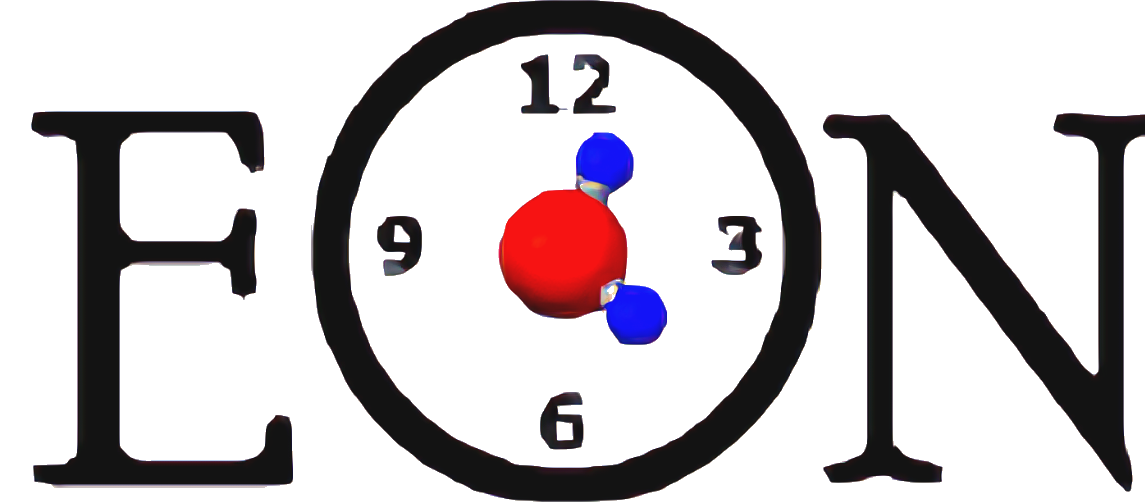Hyperdynamics#
The hyperdynamics method uses a bias potential which should be zero at transition states and positive in minima in order to accelerate the rate of transitions as noted by Voter [HD_Vot97].
The hyperdynamics time step \(\delta t\) can be obtained from the molecular dynamics simulation time step \(\delta t^b\) multiplied by a boost factor \(e^{\beta \Delta V}\), where \({\Delta V}\) is the bias potential.
There are several possible forms of bias potential. In EON, we have implemented the bond-boost method of Miron and Fichthorn [HD_MF03] where the bias potential is controlled by the maximal (fractional) change in any bond length in the system. This is a good bias potential for systems in which the dynamics is governed by bond breaking and forming events.
You can run a hyperdynamics job by:
Setting the
bias_potentialoption.Within a
parallel_replicajob.
Configuration#
[Hyperdynamics]
- pydantic model eon.schema.HyperdynamicsConfig[source]#
Show JSON schema
{ "title": "HyperdynamicsConfig", "type": "object", "properties": { "bias_potential": { "default": "none", "description": "Type of bias potential to use.", "enum": [ "none", "bond_boost" ], "title": "Bias Potential", "type": "string" }, "bb_dvmax": { "default": 0.0, "description": "The magnitude of the bond-boost bias potential.", "title": "Bb Dvmax", "type": "number" }, "bb_rmd_time": { "default": 100.0, "description": "Regular MD duration (in fs) to determine equilibrium bond length before adding bias potential.", "title": "Bb Rmd Time", "type": "number" }, "bb_boost_atom_list": { "anyOf": [ { "type": "string" }, { "items": { "type": "integer" }, "type": "array" } ], "default": "ALL", "description": "The atoms that will be displaced in the calculation: a comma delimited list of atom indices, e.g. 0,1,2. Default is 'All'.", "title": "Bb Boost Atom List" }, "bb_rcut": { "default": 3.0, "description": "Cutoff distance (in Angstroms) for bonds included in the bond-boost potential.", "title": "Bb Rcut", "type": "number" }, "bb_stretch_threshold": { "default": 0.2, "description": "Defines the bond-boost dividing surface.", "title": "Bb Stretch Threshold", "type": "number" }, "bb_ds_curvature": { "default": 0.95, "description": "Curvature near the bond-boost dividing surface.", "title": "Bb Ds Curvature", "type": "number" } } }
- Config:
use_attribute_docstrings: bool = True
- Fields:
- field bb_boost_atom_list: str | list[int] = 'ALL'#
The atoms that will be displaced in the calculation: a comma delimited list of atom indices, e.g. 0,1,2. Default is ‘All’.
- field bb_ds_curvature: float = 0.95#
It should have a value <= 1. We recommend the value to be 0.9-0.98.
Curvature near the bond-boost dividing surface.
- field bb_rcut: float = 3.0#
Cutoff distance (in Angstroms) for bonds included in the bond-boost potential.
- field bb_rmd_time: float = 100.0#
Regular MD duration (in fs) to determine equilibrium bond length before adding bias potential.
References#
Radu A. Miron and Kristen A. Fichthorn. Accelerated molecular dynamics with the bond-boost method. The Journal of Chemical Physics, 119(12):6210–6216, September 2003. doi:10.1063/1.1603722.
Arthur F. Voter. Hyperdynamics: Accelerated Molecular Dynamics of Infrequent Events. Physical Review Letters, 78(20):3908–3911, May 1997. doi:10.1103/PhysRevLett.78.3908.
